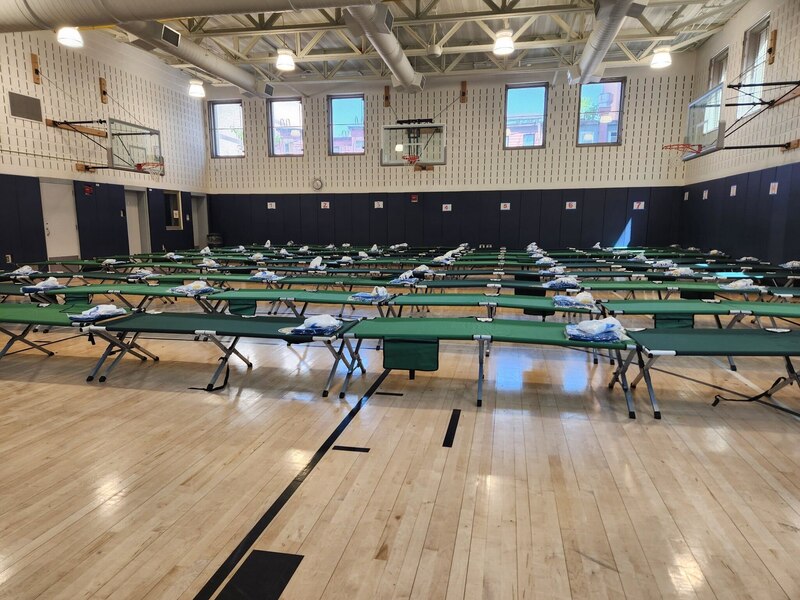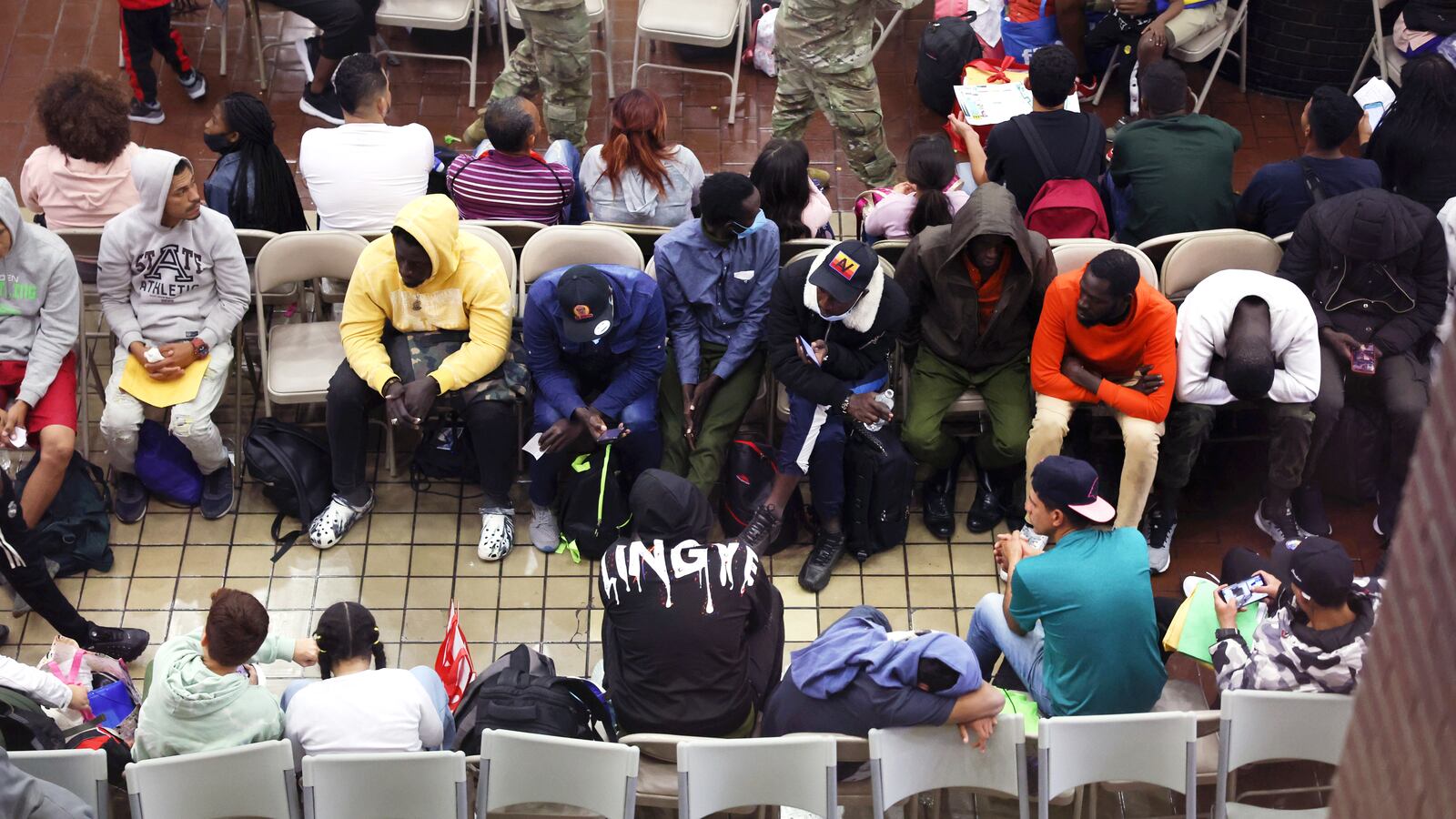Chalkbeat is a nonprofit news organization covering public education in communities across America. Sign up for Chalkbeat New York’s free daily newsletter to keep up with NYC’s public schools.
Up to 20 New York City public school gymnasiums could be transformed into emergency shelters for asylum seekers, a sudden move that Mayor Eric Adams said Tuesday he was reluctant to make.
“This is one of the last places we want to look at,” the mayor said in an interview on NY1. “None of us are comfortable with having to take these drastic steps.”
Adams contends that the city is running out of space in shelters, hotels, and other emergency accommodations as more than 65,000 asylum seekers have arrived in New York City since last year.
A handful of school gyms, largely in Brooklyn, are already being outfitted with cots, and at least one has already opened its doors to migrants. The plan has drawn concerns about possible disruption to school activities and whether the spaces have adequate access to bathrooms and showers.
Here’s what we know — and don’t know — about the city’s plans to transform schools into emergency shelters:
NYC is gearing up to use school gyms to house migrants, but only detached gyms.
Adams stressed that the city is only considering gymnasiums that are physically separated from the rest of the building, an effort to ease concerns about students coming into contact with adults who have not been vetted with background checks, as school staffers typically are.
Students are “not going to be impacted,” Adams said during a radio appearance on 1010 WINS.
City officials said the police department will be present at those sites around the clock. Still, some parent leaders said ensuring that students and migrants aren’t in contact may require logistical coordination to manage nearby entrances and exits.
So far, the city is gearing up to house migrants at the following schools in Brooklyn, according to parent leaders and news reports: Coney Island’s P.S. 188, Crown Heights’ P.S. 189, Sunset Park’s P.S. 172, and Williamsburg’s P.S. 17, P.S. 18, P.S. 132 and M.S. 577.
City officials did not provide a full list of school gyms under consideration for emergency shelter, nor did they say which buildings are currently housing migrants. The Daily News reported that some migrants were already staying at P.S. 188 over the weekend.
Former Mayor Bill de Blasio implemented a plan in 2017 to build about 75 stand-alone school gyms across the city, since many schools blamed space issues for flouting mandated minutes for gym instruction.
Tensions are rising in some school communities.
At Williamsburg’s P.S. 17, students and parents gathered Tuesday morning to protest the use of the school’s gym to house migrants. Some children held signs reading “We Need Recess!!!” and the crowd chanted, “We support asylum seekers, but not on school grounds.”
Tajh Sutton, the parent council president in Brooklyn’s District 14, which includes P.S. 17, said the lack of transparency from the city about their plans helped fuel the backlash. Sutton also contends that Adams has directly stoked anger toward migrants by regularly highlighting the costs associated with connecting them with services and claiming they have “destroyed” the city.
“He’s created the conditions for this vitriol,” she said. The protest at P.S. 17 “made me really sad because I think that parents’ frustration about not being communicated with is valid and parents’ exhaustion about a lack of transparency from the Department of Education is valid. But when you’re allowing that to let you veer into racism and xenophobia, you have to check yourself.”
Still, Sutton said some school communities are trying to be flexible. At P.S. 18, in East Williamsburg, the principal is working to communicate what’s happening with parents, funding alternative spaces for gym class, and tracking down an alternative venue for their graduation, she said. Some members of the community are working with a mutual aid group to provide toiletries to asylum seekers.
“The principal has done a really wonderful job,” Sutton said.
Groups from all corners are calling on the city to reverse course.
The city’s teachers union, local elected officials, the union representing school safety agents, and even immigrant advocates have raised concerns about the city’s plan.
“We don’t agree with utilizing active school buildings as housing for emergency shelter right now because we don’t want to disrupt a school environment,” said Murad Awawdeh, executive director of the New York Immigration Coalition.
The union representing school safety agents, who are police department employees, also claimed in a letter to city officials that they were improperly asked to “monitor recently arrived asylum seekers in schools” and contend with “agitated” local residents.

It’s not the first time schools have been used as shelters.
Nor is it the first time that families feel like they are being kept in the dark about using schools as shelters.
In the aftermath of Hurricane Sandy in 2012, then-Mayor Michael Bloomberg opened emergency shelters in 76 public schools for New Yorkers who had no place to go after the storm flooded their homes or residential facilities.
At Brooklyn Tech, the nation’s largest brick-and-mortar high school, more than 200 adults from assisted living facilities in the Rockaways stayed in the school’s cafeteria and other spaces for two weeks while class was in session. The residents shared entrances with the students unlike the city’s current plan where there are separate entrances for the shelter.
“It was a terrible situation for all of these people who were homeless and displaced,” recounted Elissa Stein, a high school admissions consultant, who had a child at Brooklyn Tech at the time. “But the kids were having this experience that wasn’t necessarily safe.”
Residents needed medical services, like blood draws, and families were concerned about medical waste as well as strangers wandering the hallways and stairwells.
The city kept promising that the shelter would wrap up, but the end date kept getting delayed, Stein said.
“It was hard to get answers,” Stein said.
The city has not yet said how long schools will operate as shelters.
The goal is to close the shelters “as soon as possible,” a city hall spokesperson said. Officials did not provide a firm timeline, though, and noted that they have run out of space elsewhere and are seeking federal and state help.
Education officials acknowledge school programming may be affected.
The full scope of how school activities could be disrupted remains unclear.
At Williamsburg’s P.S. 17 and M.S. 577, which share a gym, parents were concerned that kids would lose their gym and also lose outdoor recess and some after-school activities since the gym fronts the playground, according to the New York Post.
City officials said they’re working to select facilities that wouldn’t have a direct effect on programming, but they acknowledged some schools will have to shift their physical education classes to a different venue, including outdoors or in other school spaces.
Under state law, children in elementary school are required to have at least 120 minutes of physical education each week. Middle schoolers must have at least 90 minutes, and high school students are required to have at least 180 minutes for seven semesters.
Officials say the gyms are supposed to house adults, not children.
As the influx of migrants has strained the existing shelter system, Adams last week used an executive order to temporarily suspend some of the city’s rules around guaranteeing the right to shelter, including the requirement to place families in private rooms with bathrooms and kitchens. That could provide a path for the city to house children in school gyms, but a legal aid attorney told THE CITY that state regulations still prohibit children from group shelter settings, and that the city has moved children out of such sites after learning they were there.
A City Hall spokesperson said their “intent” is to only house adults in school gyms.
The city has not explained how habitable the gyms are.
City officials did not share information on what kinds of facilities the gyms offer, such as adult toilets or showers. While high school gyms might have showers, typically elementary and middle schools do not, and all of the schools currently identified as housing asylum seekers are elementary and middle schools.
Jessamyn Lee, an elected parent member of the city’s Panel for Educational Policy, said details have been scarce about whether the city plans to bring in shower or bathroom trailers and how that might work logistically. “Where will those go — are they going in the street? Are they going in school yards? No information has been released,” she said.
Residents around at least two of the schools, Coney Island’s P.S. 188 and Sunset Park’s P.S. 172, filed complaints with the Department of Buildings raising questions about the legality of using the gyms to house people, public records show.
Alex Zimmerman is a reporter for Chalkbeat New York, covering NYC public schools. Contact Alex at azimmerman@chalkbeat.org.
Amy Zimmer is the bureau chief for Chalkbeat New York. Contact Amy at azimmer@chalkbeat.org.


